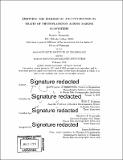| dc.contributor.advisor | Soiia T. Dyhrman and Elizabeth B. Kujawinski. | en_US |
| dc.contributor.author | Alexander, Harriet, Ph. D. Massachusetts Institute of Technology | en_US |
| dc.contributor.other | Woods Hole Oceanographic Institution. | en_US |
| dc.date.accessioned | 2016-06-22T17:48:54Z | |
| dc.date.available | 2016-06-22T17:48:54Z | |
| dc.date.copyright | 2016 | en_US |
| dc.date.issued | 2016 | en_US |
| dc.identifier.uri | http://hdl.handle.net/1721.1/103222 | |
| dc.description | Thesis: Ph. D., Joint Program in Applied Ocean Science and Engineering (Massachusetts Institute of Technology, Department of Biology; and the Woods Hole Oceanographic Institution), 2016. | en_US |
| dc.description | Cataloged from PDF version of thesis. | en_US |
| dc.description | Includes bibliographical references (pages 155-179). | en_US |
| dc.description.abstract | Marine phytoplankton are central players in the global carbon cycle, responsible for nearly half of global primary production. The identification of the factors controlling phytoplankton ecology, physiology, and, ultimately, bloom dynamics has been a central problem in the field of biological oceanography for the past century. Molecular approaches enable the direct examination of species-specific metabolic profiles in mixed, natural communities, a task which was previously intractable. In this thesis, I developed and applied novel analytical tools and bioinformatic pipelines to characterize the physiological response of phytoplankton to their environment at various levels of taxonomic grouping. An in silico Bayesian statistical approach was designed to identify stable reference genes from high-throughput sequence data for use in RT-qPCR assays or metatranscriptome studies. Using a metatranscriptomic approach, the role of resource partitioning in the coexistence of two closely related diatom species in an estuarine system was examined. This study demonstrated that co-occurring diatoms in a dynamic coastal system have apparent differences in their capacity to use nitrogen and phosphorus, and that these differences may facilitate the diversity of the phytoplankton. The second field study focused on the diatom, haptophyte, and dinoflagellate functional groups, using simulated blooms to characterize the traits that govern the magnitude and timing of phytoplankton blooms in the oligotrophic ocean. The results indicated that blooms form when phytoplankton are released from limitation by resources and that the mechanistic basis for the success of one functional group over another may be driven by how efficiently the transcriptome is modulated following a nutrient pulse. The final study looked at the sub-species level, examining the balance of phenotypic plasticity and strain diversity in the success of the coccolithophore Emiliania huxleyi. Results indicated strong control of nitrogen on the species complex and showed that nutrient resupply shifted the strain composition as well as transcript abundance of key biogeochemical genes involved in nutrient acquisition and the life stage of the population. Together, these studies demonstrate the breadth of information that can be garnered through the integration of molecular approaches with traditional biological oceanographic surveys, with each illuminating fundamental questions around phytoplankton ecology and bloom formation. | en_US |
| dc.description.statementofresponsibility | by Harriet Alexander. | en_US |
| dc.format.extent | 179 pages | en_US |
| dc.language.iso | eng | en_US |
| dc.publisher | Massachusetts Institute of Technology | en_US |
| dc.rights | M.I.T. theses are protected by copyright. They may be viewed from this source for any purpose, but reproduction or distribution in any format is prohibited without written permission. See provided URL for inquiries about permission. | en_US |
| dc.rights.uri | http://dspace.mit.edu/handle/1721.1/7582 | en_US |
| dc.subject | Joint Program in Applied Ocean Science and Engineering. | en_US |
| dc.subject | Biology. | en_US |
| dc.subject | Woods Hole Oceanographic Institution. | en_US |
| dc.title | Defining the ecological and physiological traits of phytoplankton across marine ecosystem | en_US |
| dc.type | Thesis | en_US |
| dc.description.degree | Ph. D. | en_US |
| dc.contributor.department | Joint Program in Applied Ocean Physics and Engineering | en_US |
| dc.contributor.department | Woods Hole Oceanographic Institution | en_US |
| dc.contributor.department | Massachusetts Institute of Technology. Department of Biology | |
| dc.identifier.oclc | 951536905 | en_US |
